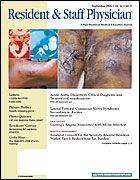Commentary
Michael D. Cirigliano, MD, FACP
Associate Professor of Medicine
Division of General Internal Medicine
University of Pennsylvania School of Medicine
University City
This case not only highlights the use and potential side effects of beta-carotene supplements but also demonstrates the importance of asking about and knowing which natural products our patients are taking.
In this particular case, the patient was by all accounts taking beta-carotene on the advice of his physicians, and using the correct dosage. Despite this, he developed the classic clinical signs and symptoms of carotenoderma.
A number of natural products, including vitamins, minerals, and herbal remedies, have been studied over the past 10 years in randomized, controlled trials that have produced mixed results. In the case of beta-carotene, various studies have evaluated its use for age-related macular degeneration (AMD). In studies published in peer-reviewed journals, the use of beta-carotene combined with vitamin C, vitamin E, and elemental zinc has been shown to reduce the risk of loss of visual acuity by as much as 27% and the risk of progression of advanced AMD by as much as 25%.1,2 However, several studies have shown no benefit when zinc was not included as part of the vitamin supplementation.1,3 This appears to indicate the presence of a more complex mechanism regarding efficacy in this disorder. Other studies have shown positive effects with high levels of dietary beta-carotene as well as use of supplemental lycopene and lutein.4,5
The exact pharmacology of beta-carotene is still being investigated. Beta-carotene consists of a number of isomers. The most common form used in clinical trials to date is synthetic beta-carotene, consisting of all "trans" forms as opposed to natural beta-carotene, which contains several cis-beta-carotene isomers.6
Beta-carotene appears to be beneficial because of its antioxidant activities in preventing lipid peroxidation.7 Several studies have indicated that there may be a reduction in free radical-induced DNA damage as well as in inflammatory markers, including C-reactive protein.8,9 Reduced risk for some cancers has been postulated, but data are lacking. In fact, taking betacarotene may result in an increased risk for lung cancer because of the production of metabolites.10
Finally, taking high dosages of beta-carotene along with other nutrients, such as selenium, vitamin C, and vitamin E, may lower high-density lipoprotein levels, resulting in a less-optimal lipid profile.11
In this particular patient, although his reversible carotenoderma was most likely benign, there were reasons to stop his supplemental beta-carotene in addition to the skin discoloration. The patient had a history of cardiovascular and lipid abnormalities. Several studies have shown a decrease in the efficacy of statins and niacin with concomitant use of beta-carotene.11,12 Therefore, increasing this patient's dietary intake of fruits and vegetables would be a more prudent approach.
Almost every patient seen in a physician's office or in the hospital will be taking some natural product these days. It is critical that as physicians we ask each and every patient about such use. Drug-supplement interactions can and do occur. Known and idiosyncratic reactions are also possible. There is most certainly a role for natural products that have been proven to be safe and effective by scientific research; however, it is our responsibility to inform our patients that just because something is "natural" does not necessarily mean it is safe.
Arch Ophthalmol
1. Age-Related Eye Disease Study Research Group. A randomized, placebo-controlled, clinical-trial of high-dose supplementation with vitamins C and E, beta-carotene, and zinc for age-related macular degeneration and vision loss. AREDS report no. 8. . 2001;119:1417-1436.
Arch Ophthalmol.
2. Age-Related Eye Disease Study Research Group. Potential public health impact of Age-Related Eye Disease Study results: AREDS report no. 11. 2003;121:1621-1624.
Arch Ophthalmol.
3. Age-Related Eye Disease Study Research Group. A randomized, placebo-controlled, clinical trial of high-dose supplementation with vitamins C and E and beta-carotene for age-related cataract and vision loss: AREDS report no. 9. 2001;119: 1439-1452.
Nutr
Res.
4. Kim MK, Ahn SH, Lee-Kim YC. Relationship of serum α-tocopherol, carotenoids and retinal with the risk of breast cancer. 2001;21:797-809.
JAMA.
5. Seddon JM, Ajani UA, Sperduto RD, et al, for the Eye Disease Case-Control Study Group. Dietary carotenoids, vitamins A, C, and E, and advanced age-related macular degeneration. 1994;272:1413-1420.
Ann
Allergy Asthma Immunol.
6. Neuman I, Nahum H, Ben-Amotz A. Prevention of exercise-induced asthma by a natural isomer mixture of beta-carotene. 1999;82:549-553.
Annu Rev Public Health.
7. Omenn GS. Chemoprevention of lung cancer: the rise and demise of beta-carotene. 1998;19:73-99.
Neoplasma
8. Krajcovicova-Kudlackova M, Dusinska M. Oxidative DNA damage in relation to nutrition. . 2004;51:30-33.
Am J Clin Nutr
9. Ford ES, Gillespie C, Ballew C, et al. Serum carotenoid concentrations in US children and adolescents. . 2002;76:818-827.
Am J Clin Nutr.
10. Russell RM. The vitamin A spectrum: from deficiency to toxicity. 2000;71:878-884.
N Engl J Med
11. Brown BG, Zhao XQ, Chait A, et al. Simvastatin and niacin, antioxidant vitamins, or the combination for the prevention of coronary disease. . 2001;345:1583-1593.
Arterioscler
Throm Vasc Biol
12. Cheung MC, Zhao XQ, Chait A, et al. Antioxidant supplements block the response of HDL to simvastatin-niacin therapy in patients with coronary artery disease and low HDL. . 2001;21:1320-1326.
